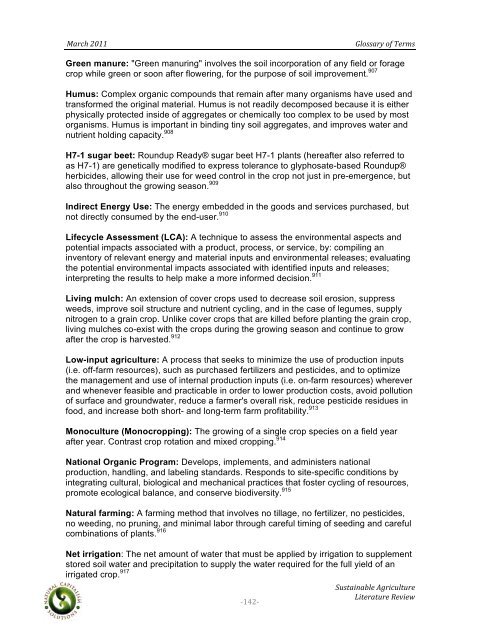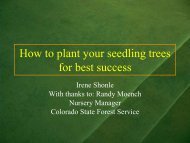Sustainable Agriculture Literature Review - Boulder County
Sustainable Agriculture Literature Review - Boulder County
Sustainable Agriculture Literature Review - Boulder County
Create successful ePaper yourself
Turn your PDF publications into a flip-book with our unique Google optimized e-Paper software.
! !!<br />
"#$%&!'())!! !!!!!!!!!!!!!!!!!!!!!!!!!!!!!!!!!!!!!!!!!!!!!!!!!!!!!!!!!!!!!!!!I/-44#$F!-J!K1$B4!<br />
Green manure: "Green manuring" involves the soil incorporation of any field or forage<br />
crop while green or soon after flowering, for the purpose of soil improvement. 907<br />
Humus: Complex organic compounds that remain after many organisms have used and<br />
transformed the original material. Humus is not readily decomposed because it is either<br />
physically protected inside of aggregates or chemically too complex to be used by most<br />
organisms. Humus is important in binding tiny soil aggregates, and improves water and<br />
nutrient holding capacity. 908<br />
H7-1 sugar beet: Roundup Ready® sugar beet H7-1 plants (hereafter also referred to<br />
as H7-1) are genetically modified to express tolerance to glyphosate-based Roundup®<br />
herbicides, allowing their use for weed control in the crop not just in pre-emergence, but<br />
also throughout the growing season. 909<br />
Indirect Energy Use: The energy embedded in the goods and services purchased, but<br />
not directly consumed by the end-user. 910<br />
Lifecycle Assessment (LCA): A technique to assess the environmental aspects and<br />
potential impacts associated with a product, process, or service, by: compiling an<br />
inventory of relevant energy and material inputs and environmental releases; evaluating<br />
the potential environmental impacts associated with identified inputs and releases;<br />
interpreting the results to help make a more informed decision. 911<br />
Living mulch: An extension of cover crops used to decrease soil erosion, suppress<br />
weeds, improve soil structure and nutrient cycling, and in the case of legumes, supply<br />
nitrogen to a grain crop. Unlike cover crops that are killed before planting the grain crop,<br />
living mulches co-exist with the crops during the growing season and continue to grow<br />
after the crop is harvested. 912<br />
Low-input agriculture: A process that seeks to minimize the use of production inputs<br />
(i.e. off-farm resources), such as purchased fertilizers and pesticides, and to optimize<br />
the management and use of internal production inputs (i.e. on-farm resources) wherever<br />
and whenever feasible and practicable in order to lower production costs, avoid pollution<br />
of surface and groundwater, reduce a farmer's overall risk, reduce pesticide residues in<br />
food, and increase both short- and long-term farm profitability. 913<br />
Monoculture (Monocropping): The growing of a single crop species on a field year<br />
after year. Contrast crop rotation and mixed cropping. 914<br />
National Organic Program: Develops, implements, and administers national<br />
production, handling, and labeling standards. Responds to site-specific conditions by<br />
integrating cultural, biological and mechanical practices that foster cycling of resources,<br />
promote ecological balance, and conserve biodiversity. 915<br />
Natural farming: A farming method that involves no tillage, no fertilizer, no pesticides,<br />
no weeding, no pruning, and minimal labor through careful timing of seeding and careful<br />
combinations of plants. 916<br />
Net irrigation: The net amount of water that must be applied by irrigation to supplement<br />
stored soil water and precipitation to supply the water required for the full yield of an<br />
irrigated crop. 917<br />
!<br />
"'*("<br />
!,342#.5#6/1!78$.%3/23$1!<br />
9.21$#23$1!:1;.1
















